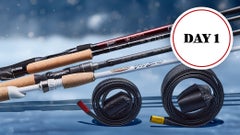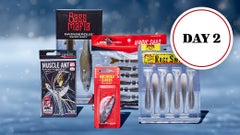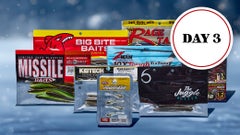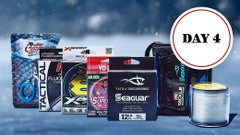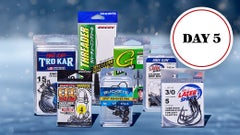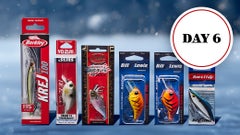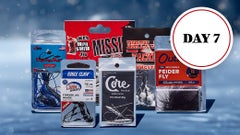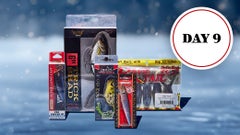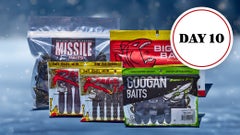FLW Tour Sam Rayburn Baits, Gear & Patterns
Phil Marks Winning Pattern, Baits & Gear
“Obviously, it’s by far the biggest tournament I’ve won,” said Marks, who lives in Dallas now. “Fishing a 4-day event like this under this much pressure for this much money, it’s a whole different mindset than going out and fishing a 1-day team tournament where you’re just trying to catch a bag full of giants. I do specialize in catching big ones because that’s what it takes to win those 1-day tournaments. You can’t push a bad hand and hero or zero one day because then you’ll be out of it. “That takes a little bit of learning over time. This is the highlight of my tournament career. I’m tickled to death in the way I won it, but I don’t have any plans to make any lifestyle changes.” Marks has seen Rayburn go through the cyclical changes it seems to be experiencing lately. After a couple years of low water, the lake came up significantly in the spring and the fishing just hasn’t been the same since. The big fish were so scattered in practice it was hard to count on them in any particular area, prompting many pros to head to the grass mats and pluck out limits of 2- to 3-pounders. Sensing the better fish were holding on distinct pieces of offshore structure and/or relating to the presence of shad, he focused his practice on main-lake flats that had sizable “drains, depressions or ditches that ran into them,” he said. “I would fish the breaks of the ditches. I wasn’t keying on brush piles. “I would find a small patch of hard bottom and that’s what I was keying on. It took me a few hours in the morning to find them and I ended up finding about six or seven spots, two of which I had knowledge of prior to this tournament.” As a backup plan, he also located some shallow fish in the back of a creek up the lake that he could pick off with a shallow-running squarebill crankbait. “It was just a typical fall pattern with a bunch of 2- and 3-pounders roaming around busting shad,” he added.
Competition:
The key part of the day for Marks during the tournament was the first 2 hours. On the first day of competition, warmer temperatures had replaced the chilly conditions that had been prevalent during practice. Changes in the weather didn’t seem to affect his deeper fish. In fact, they seemed to bite better and longer under some clouds and with some wind. He scored 17-01 on day 1 to open the event in 3rd place, catching his bigger fish on deep-diving crankbaits, including a prototype Strike King Series 10XD, and cleaning up with a big football jig. “I had to do my damage really in the first hour,” he said. “It was about a 20-minute run to get down to where I was at so I had a limited window. The drains I was targeting, I’d crank right up the middle of them first thing in the morning just looking for them. If I saw some on the DownScan, I’d swing the boat around and throw a 1-ounce Strike King football jig out there or an 8-inch Strike King Rage Recon worm. You had to keep moving and fish fast to catch those active fish.” He knew he was around some big fish from the get-go as his co-angler on the first day stuck a 9-pounder. The early bite didn’t happen for him on day 2 and he made the move to his fish in the back of the creek, where he caught 14-02 that kept him in 3rd place entering the weekend. “I only had one 14-incher and ran to my backup spot with some shallow fish in 2 to 4 feet that no one else in the tournament had found,” he said. “Those fish saved me. I ran up there and managed to get up to 14 pounds and that kept me in the hunt.”
He started dialing in the bigger fish on day 3, weighing a 5- and 7-pounder from the same honey hole that kicked out a 5 on day 1 as he took the lead from Combs with an 18-01 sack. He had learned the area so well on his electronics that he could literally tell the difference between a school of threadfin shad and gizzard shad and, in turn, could predict what size bass were stalking which bait. “I could tell the difference between little Kentuckys and smaller balls of threadfin shad,” he said. “What I was looking for were big-looking fish that were chasing gizzard shad, which look a lot different than a school of threadfins on the DownScan. When I’d see those what I call ‘worms’ on the screen and if I saw gizzard shad, I was fixing to get bit by a big one. “I was moving the crankbait pretty fast and I could tell by the thickness of the mark whether it was a spotted bass or a 6-pounder.” Day 4 brought about another drastic weather shift, but it had Marks pumped up since he was sure his offshore fish would fire with the windy and rainy conditions. Once again, the first 90 minutes of the day proved to be crucial as he caught giant after giant off the same spot that produced his big fish on days 1 and 3. His lightest fish was a 5 3/4-pounder. “When we’d get some weather, they’d just bite longer and more aggressively,” he said. “I caught them just like this during all 3 days in practice and all 4 days of the tournament. If you do something for a week straight, you can get pretty good at it. The last two days I was fortunate enough to catch some of those big ones early.”
Winning Gear:
Crankbait gear: 7’3” medium-heavy Power Tackle Paragon Series casting rod, Quantum Tour KVD casting reel (7.3:1 ratio), 12-pound Gamma fluorocarbon line, Strike King Series 6XD crankbait (pearl/black splatter with chartreuse belly). When he threw the 10XD (same color as 6XD), he used an 8’ Power Tackle Swimbait Special rod – a regular cranking rod is too limber – with 16-pound Gamma fluorocarbon. He also put 2/0 Mustad KVD Elite Series Short Shank Triple Grip treble hooks on the bait, which allowed him to swing his bigger fish into the boat. “When I’d get them, it was like I had six jig hooks in them,” he said. “I swung two of the big ones (on day 4). The 8-pounder wasn’t hooked too good, so I lipped him. You can be pretty rough with them. Some people were freaking out when they showed some of the footage at the weigh-in.” More on the 10XD: “It’s not a magic bait. Big fish eat big bait,” he said. “That’s the big deal. Those bass at Rayburn eat Kentucky spotted bass and giant gizzard shad. They were spitting up Kentuckys in my livewell, 8 and 10 ounces at a time. That being said, you can go a long time without getting a bite, but when you do get a bite, it’s going to have some size.” On day 2, most of his fish came on a Strike King KVD 1.0 squarebill.
Jig gear: 7’6” medium-heavy Power Tackle Paragon Series casting rod, Shimano Curado casting reel (7.1:1 ratio), 20-pound Gamma fluorocarbon line, 1-ounce Strike King Tour Grade Heavy Hook football jig (peanut butter and jelly), Strike King Rage Craw trailer (junebug or candy craw).
He used the junebug trailer in low-light conditions and switched to the candy craw once the sun broke through. He also caught a few fish on a Texas-rigged 8” Strike King Rage Recon Worm.
Main factor: “Targeting big fish and fishing water that other people weren’t fishing. I was targeting those bigger fish, but I was also prepared to make a move if I needed to go fill out a limit up shallow. My fish were different-looking, too. A lot of guys’ fish were long, skinny fish from up shallow. My fish were fat and round. They were just different-looking fish.”
Performance edge: “I could not have lived without the Lowrance HDS-10s and the StructureScan. I’d crank down those drains and a lot of the fish wouldn’t be in the same place. They’d move up and down these ditches and if I didn’t catch one on a crankbait to let me know they were there, I’d see them on the DownScan, then spin around and throw the jig out. That was critical.”
Sam Rayburn FLW Tour Winning Pattern Bassfan 10/16/12 (Todd Ceisner)
Keith Combs' Pattern, Baits & Gear
Worm gear: 7’6” medium-heavy Power Tackle Paragon Series casting rod, Shimano Chronarch casting reel (7.1:1 ratio), 20-pound Seaguar InvisX fluorocarbon line, unnamed 1/2-ounce bullet weight, 4/0 Owner offset wide gap worm hook, 8” Strike King Rage Recon Worm (plum).
Crankbait gear: 7’ medium-heavy Power Tackle Paragon Series casting rod, same reel, 15-pound Seaguar InvisX fluorocarbon line, Strike King Series 6XD crankbait (sexy shad). He swapped out the stock hooks on the 6XD for size 2 Owner Stinger trebles.
Main factor: “Spending time there before it went off limits. I spent the time out (deep) just in case, just to find a few more spots so in that time I ended up finding everything that panned out for me.”
Performance edge: “Humminbird Side Imaging. The best stuff was stuff I found in pre-practice. They weren’t really things I’d fished before. I was in areas of the lake that I like to fish, but that stuff is so good that you can tell if it’s a new brush pile and still has leaves on it or if it’s an old brush pile that somebody sunk 2 or 3 years ago. This lake has gotten so low a couple times that a couple of the stumps are what I call spider stumps because they have this dramatic root system that just goes everywhere. They’re huge stumps, but they’re completely washed out and when you can find a cluster of those, it’s money in the bank that there will be fish around those sometime during the day. When you can find them in 18 to 20 feet of water, it’s guaranteed. Without that Side Imaging, I wouldn’t have cracked the Top 10.”
Sam Rayburn Patterns 2-5 Pattern Bassfan 10/17/12 (Todd Ceisner)
Jacob Wheeler's Pattern, Baits & Gear
Flipping gear: 7’11” G. Loomis GLX Flipping Series casting rod, Shimano Curado casting reel (7.0:1 ratio), 65-pound Sufix 832 Advanced Superline (lo-vis green), unnamed 1-ounce flipping weight, 4/0 VMC flipping hook, 4” Trigger X Goo Bug (black red flake, black blue sapphire, Carolina bug).
He caught his best fish flipping the Carolina bug color when it was cloudy and when it was sunny, the black red flake pattern produced better. He started the tournament with just five bags of the baits and by the final day had resorted to super-gluing them back together and dipping others in black dye to mimic the best-performing colors.
Main factor: “Just fishing my strength was a big thing. I was fishing how I wanted to fish and didn’t go into the tournament with any preconceived notions. I just rolled with it. That was a really big thing. Adapting to every condition was huge.”
Performance edge: “My Power-Poles were a huge part of flipping those mats. Obviously, the Trigger X Goo Bug was by far, in my opinion, the deal. I know I wouldn’t have been in this position without it.”
Sam Rayburn Patterns 2-5 Pattern Bassfan 10/17/12 (Todd Ceisner)
Landan Ware's Pattern, Baits & Gear
Crankbait gear: 7’3” medium-action Power Tackle Paragon Series casting rod, Shimano Chronarch casting reel (7.1:1 ratio), 12-pound Seaguar InvisX fluorocarbon line, Norman DD22 crankbait (chartreuse/shad pattern). He swapped the stock hooks on the DD22 for size 2 Mustad KVD Elite Short Shank trebles. He tried throwing the Strike King 6XD, but had better success with the DD22. “It has a little bigger wobble and for whatever reason, I had more success on that bait.”
Topwater gear: 7’ heavy-action Power Tackle Paragon Series casting rod, same reel, 40- and 65-pound PowerPro braided line, Heddon Zara Spook (shad pattern), 1/2-ounce Yellow Magic (shad pattern). He threw the Spook on 65-pound braid.
Main factor: “Being versatile and being comfortable fishing shallow in the grass and being willing to run out deep and then coming back to keep fishing shallow. It didn’t bother me and I had to do it both ways to get it done.”
Performance edge: “My Lowrance SideScan. I could actually see the fish in the brush out beside me. I have the transducer on my trolling motor so I could move my trolling motor one way and if there’s a brush pile to the right or if there’s fish around that brush, you can see those fish. It’s crazy.”
Sam Rayburn Patterns 2-5 Pattern Bassfan 10/17/12 (Todd Ceisner)
Chad Grigsby's Pattern, Baits & Gear
Flipping gear: 7’11” heavy-action St. Croix Legend Tournament casting rod, Agu Garcia Revo MGX casting reel (7.9:1 ratio), 50-pound Sufix 832 braided line, 3/4-ounce Secret Lures HD Flippin’ Jig (black & blue), Zoom Big Salty Chunk trailer (black blue flake).
He also flipped a Gambler Why Not (junebug) on a 6/0 VMC flipping hook under a 1.5-ounce weight.
Main factor: “Being patient more than anything. The bites didn’t come fast and furious. You had to be committed to it or go do something else. A lot of guys I talked to you were like, ‘Man, I flipped grass for like 2 hours and never had a bite.’ So did I, but then after 2 1/2 hours, I caught two on back-to-back casts. One thing that helped was when I went out deep, all I saw were little ones so I knew that wouldn’t do me any good. I knew I had to grind it out for 8 hours and if I got five bites, they were going to be 13 or 14 pounds or they could be 20.”
Performance edge: “Power-Poles. As much as the wind was blowing the last 2 days, even though a lot of the areas were 10 feet deep, you could still put them down and they’d drag through the grass and slow you down enough where you could actually fish.”
Sam Rayburn Patterns 2-5 Pattern Bassfan 10/17/12 (Todd Ceisner)





















